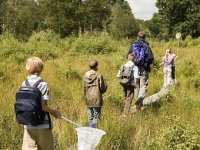Learning With Nature
Since experiencing nature is a healthy part of child development, take your class outdoors and use elements of nature for teaching the usual classroom subjects.
In our time of fast-paced, exam-pressured, high-tech culture, where does learning with nature have a place?
When adults are asked to recall a time in their youth when they were happiest, invariably they refer to times spent outdoors and with friends. Our clever screen world keeps us busy and on the go, but does not help us to communicate, feel loved, gain the satisfaction of the quiet mind, and relax. Time with others in nature does exactly that -- and much, much more!
Engaging and Thriving
We need an education that includes learning and understanding how the world is much more than human-centered, and that instills in us a sense of belonging and curiosity about life. When subject learning takes place outside, it becomes embodied and has greater meaning. Our work aims to bring the subjects outside while building meaningful relationships with the natural world. For example, a tree becomes a living being with its own characteristics and often with healing properties. The class "builds a tree" using all the parts: the bark, xylem, cambium, sapwood, heartwood, roots, and leaves. Real experiences build empathy, a hallmark of a healthy human.
In language arts classes, sensory description supports a good piece of creative writing and generally helps the reader to be "in" the piece. If we ask students to describe what things smell and sound like, their attention is drawn to notice the smells of soil, how rough some tree bark may feel, or the sound of the wind through branches. One consequence of this sensory focus is improved, descriptive writing full of imagination -- with an added bonus of high marks on writing assignments!
Young children thrive outdoors. They develop their sense of balance by moving, not by sitting down, and exploring the world around them. We all need encouragement to take risks, building up our resilience and confidence -- the skills that will equip us all our life.
We live in a time where disconnection is rife. It is common for 14-year-olds to not know that a book is made from a tree or that the fuel for their school bus comes from the earth long before it comes from the petrol station.
We have taken hundreds of young people out into nature for a one-time afternoon session, overnight or weeklong camping trips, and regular ongoing woodland programs. We have worked with young people from a wide diversity of backgrounds. The satisfaction of seeing them transform from indoor kids afraid of nature, recoiling at the yuck factor and the thought of getting dirty, to brave young adventurers diving into bushes to hide from the "eagle eyes" that will be looking for them in "3, 2, 1…" makes it all worth the effort.
Outdoor Learning
There are hundreds of activities that we could suggest, but here are a couple of the simplest, most accessible, and effective.
Try a scavenger hunt in an outdoor area. In small groups or in pairs, children must seek different objects that you have written on their list, such as:
- A feather
- An acorn
- Something that's been eaten
- Something that smells
- A seed
- Something that's rough
- Something that's heavy
- Something yellow
- An animal hair
Depending on your age group, it can be fun to add objects that engage the imagination even more, such as something that could be a gnome's hat. Once many objects have been gathered, you could use them in many ways depending on your aims and objectives. You could talk about classification and group the objects according to whether they belong to the animal, mineral, or plant kingdoms. You might keep some of the more robust items in a bag and have a child feel inside, pick one up, and describe what he or she can feel while the others guess, thus developing vocabulary and understanding of adjectives.
Before launching into any biology around botany, plant life, and transpiration, it can be a fun challenge to try doing leaf puzzles with your class. This is just like a jigsaw puzzle. We start by choosing a leaf that is at least as long as an adult’s palm and tearing it into four or more pieces (depending on age and ability of your students). Give each child a single torn leaf and break the class into pairs. Partners trade leaves and try to put the puzzle back together again. Children often soon notice how the veins can help them in rearranging their leaves and detecting differences in the upper and lower sides. Just be mindful not to include any leaves that could be toxic. Common examples that work well include hazel, lime, oak, and dandelion.
In the end, we hope that our children will be healthy and happy, and that they'll have a good future. It's unusual to hear people ask whether nature has a place in education. How can it not? The most important question of our time is how we can look after the natural world, because we need so much from it to sustain us. The future belongs to a generation who figures out how to do this.
